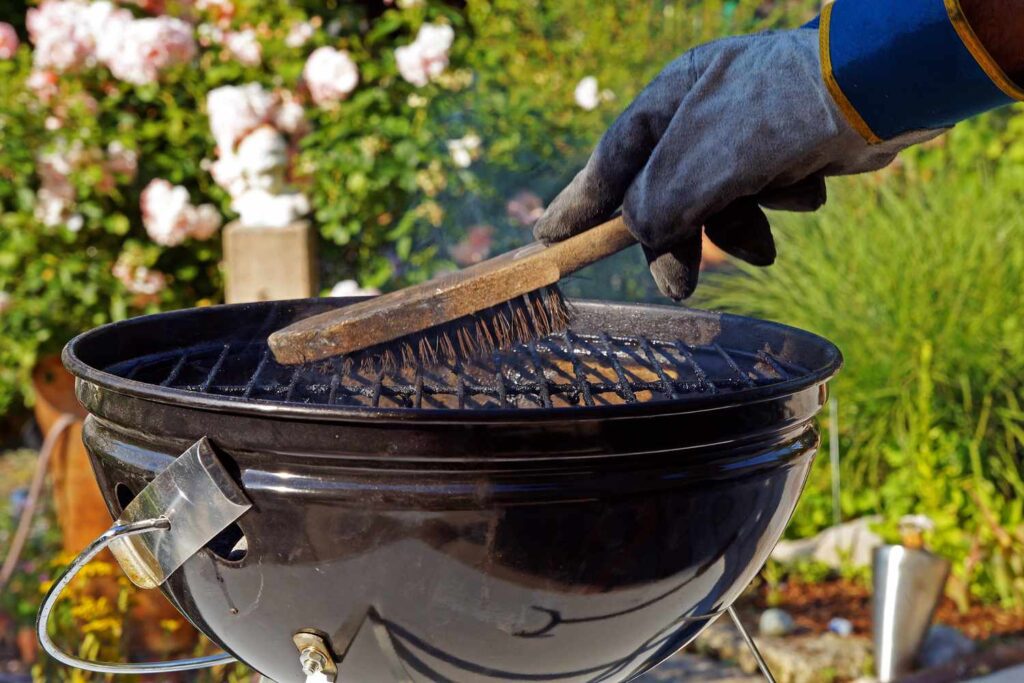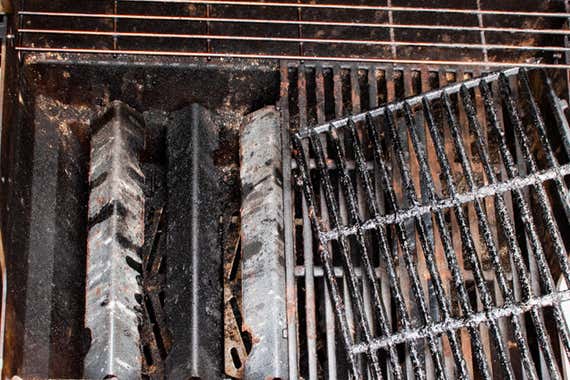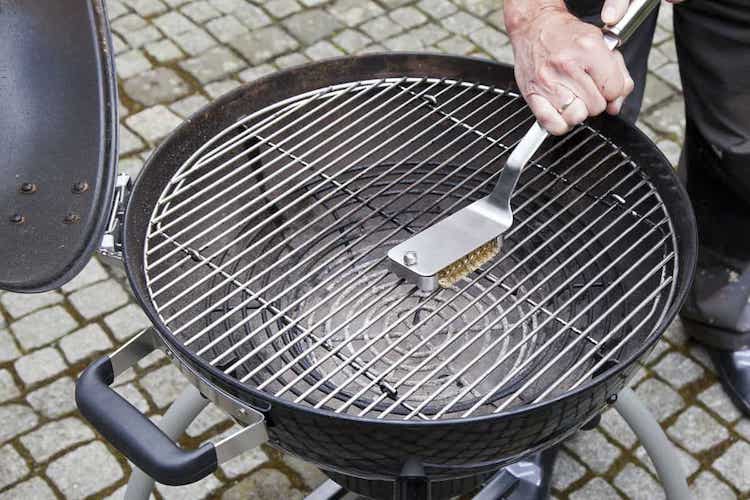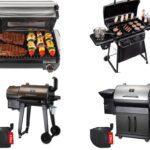
You’re not alone if you’ve ever struggled to clean your grill after a delicious backyard BBQ. Cleaning grills can be daunting, especially when the grease and food residue become stubbornly stuck. That’s why we’re excited to introduce the “What Is The Easiest Type Of Grill To Clean?”
This innovative product aims to simplify the cleaning process by identifying the easiest type of grill to maintain. Say goodbye to scrubbing for hours and hello to effortlessly cleaning grills with our game-changing solution.
Gas Grills
Gas grills are popular among enthusiasts for their convenience and ease of use. They are known for their quick heating and consistent temperature control, making them perfect for outdoor cooking. Gas grills come in two types: traditional gas grills and portable gas grills.
Traditional Gas Grills
Traditional gas grills are the most common type of gas grill found in many homes. They typically have a large cooking surface, multiple burners, and a gas tank. These grills offer plenty of space for cooking various foods at once, making them ideal for hosting backyard barbecues and gatherings.
Cleaning a traditional gas grill is relatively straightforward. After each use, it is advisable to scrape off any food debris from the grates using a grill brush. This will prevent grease buildup and ensure a clean cooking surface for your next grilling session. Additionally, cleaning the drip tray regularly is recommended to prevent grease buildup and potential fire hazards.
Portable Gas Grills
A portable gas grill may be your perfect choice if you enjoy outdoor adventures and picnics. These grills are compact and lightweight, making them easily transported and set up anywhere. Portable gas grills are powered by small propane canisters, which provide a convenient fuel source for grilling on the go.
Cleaning a portable gas grill follows a similar process to traditional gas grills. It is essential to clean the cooking grates thoroughly after each use to prevent the buildup of grease and food residue. Additionally, since portable gas grills often have limited space, cleaning the drip tray regularly is crucial to maintain optimal performance.
Electric Grills
Electric grills offer a convenient and hassle-free grilling experience. They are suitable for indoor and outdoor use, making them an excellent option for individuals who live in apartments or have limited outdoor space. Electric grills come in two main types: indoor electric grills and outdoor electric grills.
Indoor Electric Grills
Indoor electric grills are designed for kitchens, allowing you to enjoy the flavors of grilled food indoors, regardless of the weather conditions outside. These grills typically feature a non-stick cooking surface and adjustable temperature control, allowing you to perfectly grill various types of food.
Cleaning an indoor electric grill is relatively easy. Since most indoor electric grills have removable cooking surfaces, you can easily wash them in the sink or dishwasher. Additionally, wiping the grill’s exterior with a damp cloth will ensure it remains clean and ready for future use.
Outdoor Electric Grills
Outdoor electric grills are specifically designed for outdoor use, providing an alternative to traditional gas or charcoal grills. These grills are handy for individuals who prefer the convenience of electric grilling but still want to enjoy the outdoor grilling experience.
Cleaning an outdoor electric grill primarily involves cleaning the cooking grates and removing any food residue or grease buildup. Most outdoor electric grills come with a removable drip tray, making it easier to dispose of excess grease or drippings.
Regular maintenance and cleaning will ensure that your outdoor electric grill remains in top condition and ready for your next outdoor cooking adventure.

This image is property of hips.hearstapps.com.
Pellet Grills
Pellet grills have gained popularity recently due to their versatility and ability to infuse a smoky flavor into grilled food. These grills use wood pellets as fuel, which adds a unique taste profile to your favorite meats and vegetables.
Understanding the features of pellet grills and how to clean them properly is essential for maximizing their performance.
Features of Pellet Grills
Pellet grills offer several features that make them attractive to grill enthusiasts. They typically have precise temperature control, allowing you to set and maintain the desired cooking temperature throughout the grilling process.
Additionally, pellet grills often come with a hopper for storing wood pellets, which are automatically fed into the fire pot to create that delicious smoky flavor.
Cleaning a pellet grill involves several steps. It is essential to remove the leftover ash and residue from the fire pot regularly. This can be done using a vacuum or specialized ash removal tools.
It is also necessary to clean the cooking grates thoroughly to prevent the buildup of food particles and grease. Finally, emptying and cleaning the grease tray should be a regular part of your maintenance routine to keep your pellet grill in optimal working condition.
Cleaning Pellet Grills
Cleaning a pellet grill requires more effort than other grills, mainly due to the ash and grease buildup. After each use, removing any remaining wood pellets from the hopper and cleaning out the fire pot to prevent obstructions is important. Additionally, cleaning the cooking grates with a grill brush and removing any excess grease from the grease tray will contribute to a clean and functional pellet grill.
Charcoal Grills
Charcoal grills offer a classic experience and are favored by many enthusiasts for the unique smoky flavors they impart to food. They come in two main types: traditional charcoal grills and kamado grills. Understanding the differences between these two types and how to clean them effectively will ensure a successful grilling experience.
Traditional Charcoal Grills
Traditional charcoal grills are the iconic backyard grills many envision when considering outdoor cooking. They consist of a charcoal grate, a cooking grate, and a venting system for flame regulation. Traditional charcoal grills require charcoal briquettes or lump charcoal as the primary fuel source.
After each use, cleaning a traditional charcoal grill involves removing the ash and residue from the charcoal grate. To make the cleaning process easier, it is recommended to empty the ash catcher before grilling and to clean the cooking grates regularly.
Using a grill brush to scrape off any remaining food particles will help maintain a clean cooking surface and prevent flare-ups during grilling.
Kamado Grills
Kamado grills, also known as ceramic grills, have gained popularity for their superior heat retention and versatility. These grills are typically made of ceramic material, allowing for excellent temperature control and heat distribution. Kamado grills suit various cooking methods, including grilling, smoking, and baking.
Cleaning a Kamado grill requires some additional care due to its ceramic construction. After each use, removing any ashes from the bottom of the grill and cleaning the cooking grates thoroughly is important.
A grill brush or scraper specifically designed for ceramic grills will help remove any excess debris and ensure a clean cooking surface. Wiping the grill’s exterior with a damp cloth will keep your Kamado grill looking its best.

This image is property of www.foodandwine.com.
Infrared Grills
Infrared grills have gained popularity for their ability to cook food quickly and evenly. They use infrared technology to generate intense heat, resulting in faster cooking times and reduced flare-ups. Understanding how infrared grills work and how to clean them properly will help you make the most of this innovative grilling technology.
How Infrared Grills Work
Infrared grills use a ceramic or metal plate to radiate heat directly onto the food, rather than relying on hot air circulation like traditional grills. This intense heat sears the food, resulting in faster cooking and enhanced flavor.
Infrared grills also reduce flare-ups, as the heat is concentrated and does not come into direct contact with the food drippings.
Cleaning an infrared grill involves several steps. It is important to clean the cooking grates after each use, as food particles and grease can accumulate over time. A grill brush designed for infrared grills will help remove excess debris and ensure a clean cooking surface.
Additionally, cleaning the infrared plate or burner is important to maintain optimal heat distribution and prevent obstructions.
Cleaning Infrared Grills
Proper cleaning and maintenance of an infrared grill are crucial for its longevity and performance. After each use, removing any excess food residue from the cooking grates using a grill brush is important. Regularly cleaning the infrared plate or burner ensures optimal heat distribution and prevents blockages.
To clean the infrared plate or burner, it is advisable to refer to the manufacturer’s instructions, as the cleaning process may vary depending on the specific model. A grill brush or scraper designed for infrared grills will help remove any excess debris.
Additionally, wiping down the grill’s exterior with a damp cloth will help maintain its appearance and keep it looking clean and inviting.
Grill Mats
Grill mats are a handy accessory for any grill and can make cleaning up after cooking a breeze. These mats are typically made of non-stick materials and can be placed directly on the grill grates, providing a protective barrier between the food and the grates. Grill mats are especially useful for preventing food from sticking to the grates and facilitating easy cleanup.
Using a grill mat is simple and convenient. Place the grill mat directly on the grates before preheating and cooking. The mat will prevent food from falling through the grates and help retain the flavors and juices of the food. After cooking, allow the grill and the mat to cool down before removing the mat and cleaning it as per the manufacturer’s instructions.
Grill mats are reusable and can withstand high temperatures, making them a valuable tool for maintaining a clean grill while enjoying the benefits of grilling.

This image is property of cdn.thewirecutter.com.
Cleaning and Maintenance Tips
Now that we have explored the different types of grills and how to clean them let’s delve into some general cleaning and maintenance tips to keep your grill in top condition.
Regular Cleaning
Regular cleaning is key to maintaining a clean and functional grill. After each use, removing any food debris from the cooking grates using a grill brush is important. This will prevent the buildup of grease and residue, which can affect the flavor of your food and potentially cause flare-ups during future grilling sessions. Additionally, cleaning the drip tray or grease catcher to remove any excess grease is essential for preventing fire hazards.
Deep Cleaning
Performing a deep cleaning of your grill periodically is crucial to remove any stubborn grime or grease buildup. This involves disassembling various grill components, such as the cooking grates, burner tubes, and drip trays, and cleaning them thoroughly. Use warm soapy water or specialized grill cleaning solutions to remove caked-on residue. Rinse the components with clean water and let them dry completely before reassembling the grill.
Using Grill Brushes
Grill brushes are essential tools for maintaining a clean grill. They are designed with stiff bristles that help scrape off food particles and grease from the cooking grates. When using a grill brush, ensure the bristles are in good condition and not worn down. Replace the brush if the bristles become loose or damaged, as loose bristles can easily get lodged in the food.
Using Cleaning Solutions
Using specialized grill cleaning solutions can help remove stubborn stains and grease buildup. These solutions are designed to be safe for grills and effectively dissolve grease and grime. Before using any cleaning solution, always read the manufacturer’s instructions carefully and test it on a small, inconspicuous area of the grill to ensure compatibility.
Seasoning the Grill
Seasoning the grill is important in maintaining its performance and preventing rust. Seasoning involves coating the cooking grates and other metal components with a thin layer of oil to create a non-stick surface and protect against corrosion.
To season the grill, preheat it to a high temperature and brush the grates with oil using a brush or paper towel. Allow the grill to cool down, and wipe away any excess oil. This process should be done periodically or whenever you notice rust or deterioration.
Comparing Ease of Cleaning
When choosing a grill, considering the ease of cleaning can greatly impact your overall grilling experience. Here are some factors to consider and tips for choosing an easy-to-clean grill.
Factors to Consider
Several factors can influence the ease of cleaning a grill. These factors include the type of fuel used, the design and construction of the grill, and the materials used for the cooking grates and other components. Gas grills, for example, tend to be easier to clean than charcoal grills due to their relatively simple design and removable drip trays.
Gas vs. Charcoal vs. Electric
Gas grills are generally considered easier to clean than charcoal ones, as they typically have removable and easy-to-clean components. Gas grills also tend to have fewer crevices and hard-to-reach areas, making cleaning more manageable. However, advances in technology and design have also made certain charcoal and electric grills easier to clean.
Indoor and outdoor electric grills are often praised for their simple cleanup process. Since they do not produce charcoal residue or ash, cleaning mainly focuses on the grill’s cooking grates and exterior. Indoor electric grills, in particular, may have removable cooking surfaces that can be washed in the sink or dishwasher, making cleanup a breeze.
Charcoal grills require more effort to clean due to the ash and residue produced during grilling. However, certain features such as removable ash catchers and easy-to-access cooking grates can significantly simplify cleaning. With their ceramic construction and efficient heat retention, Kamado grills often have removable fire pots and ash drawers, making maintenance and cleaning more manageable.
Tips for Choosing an Easy-to-Clean Grill
When selecting a grill, consider the availability of removable parts that can be easily cleaned. Look for features such as removable cooking grates, ash catchers, and drip trays, as these components typically require the most attention during cleaning.
Grills with smooth surfaces and fewer crevices are generally easier to clean. Avoid grills with intricate designs or hard-to-clean areas, as these can trap food particles and grease, making cleanup more challenging.
Lastly, reading customer reviews and researching specific grill models can provide valuable insights into the ease of cleaning and maintenance. Look for feedback from other grill enthusiasts who have firsthand experience with the grill you are considering, as their insights can help inform your decision.

This image is property of bbqchamps.com.
Conclusion
Choosing the easiest type of grill to clean ultimately depends on your personal preferences and needs. Gas grills, such as traditional and portable ones, are generally considered convenient and straightforward to clean indoors or outdoors; electric grills offer a hassle-free grilling experience with minimal cleanup.
Pellet grills, while offering excellent flavor and versatility, require more effort in terms of cleaning due to the ash and grease buildup. Charcoal grills, including traditional charcoal and kamado grills, provide a classic grilling experience but may require more attention and maintenance.
Infrared grills offer quick and even cooking with their intense heat and reduced flare-ups, but cleaning the infrared plate or burner is crucial for optimal performance. Using grill mats can significantly simplify the cleaning process for any grill.
Remember to clean your grill regularly, perform deep cleanings as needed, and use appropriate cleaning tools and solutions. Consider the factors that impact the ease of cleaning when choosing a grill, and look for models with removable parts and easy-to-clean surfaces.
By following these tips and techniques, you can keep your grill in top condition, ensuring many enjoyable and delicious grilling experiences to come. Happy grilling!






